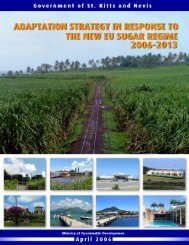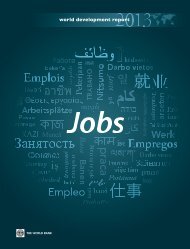Business Removing
Doing Business in 2005 -- Removing Obstacles to Growth
Doing Business in 2005 -- Removing Obstacles to Growth
- No tags were found...
Create successful ePaper yourself
Turn your PDF publications into a flip-book with our unique Google optimized e-Paper software.
32 DOING BUSINESS IN 2005<br />
FIGURE 4.6<br />
Who loses from rigid employment regulation?<br />
Informal sector<br />
Child participation in employment Income share of the poorest 20%<br />
Greater<br />
share<br />
Greater<br />
share<br />
Greater<br />
share<br />
Lesser<br />
share<br />
Lesser<br />
share<br />
Lesser<br />
share<br />
Least<br />
rigid<br />
Most<br />
rigid<br />
Countries ranked by<br />
rigidity of employment, quintiles<br />
Note: Analysis controls for income per capita. Relationships are significant at the 5% level.<br />
Source: Doing <strong>Business</strong> database, World Bank (2004a).<br />
Least<br />
Most<br />
difficult<br />
difficult<br />
Countries ranked by<br />
difficulty of hiring, quintiles<br />
Least<br />
costly<br />
Countries ranked by<br />
firing cost, quintiles<br />
Most<br />
costly<br />
Notes<br />
1. European Commission (2002).<br />
2. Di Tella and McCullom (1999).<br />
3. ILO (1998).<br />
4. OECD (2004).<br />
5. In the case of Latvia, for transport businesses only.<br />
6. OECD (2004).<br />
7. But note that previous reforms in Italy have not always achieved the<br />
desired effects.<br />
8. Eironline (2004).<br />
9. Jurajda and Mathernova (2004).<br />
10. Eleven countries do not have a mandated minimum wage either by<br />
law or by economy or industrywide collective agreements. These are<br />
Ethiopia, Guinea, Hong Kong (China), Kuwait, Malaysia, Namibia,<br />
Saudi Arabia, Singapore, Switzerland, the United Arab Emirates and<br />
Yemen. They use other means for trying to provide good living standards<br />
for their working population.<br />
11. Most studies express the minimum wage as a percentage of the average<br />
wage. However, data on average wages are only available for about 30<br />
countries outside the OECD. In the absence of such data, the use of<br />
value added per worker is necessary.<br />
12. See, for example, Neumark, Cunningham and Siga (2003).<br />
13. Rutkowski (2004).<br />
14. The methodology in last year’s report was different. This year’s changes<br />
bring the methodology closer to the one developed in Botero and others<br />
(forthcoming).<br />
15. Echeverry and Santa Maria (2004).<br />
16. Heckman and Pages (2003).<br />
17. Saavedra and Torero (2003).<br />
18. OECD (2004).<br />
19. A number of countries have conducted studies on the effectiveness of<br />
such reform in attracting young employees and providing them onthe-job<br />
training. All have found positive results. See, for example, Neumark<br />
and Wascher (2003).<br />
20. Normal production is 200 workers @ 40 hours = 8,000 hours. A 50%<br />
increase in demand requires 12,000 hours. The 200 workers can work<br />
3 hours per day overtime, or 55 hours per week. Production with current<br />
workers therefore expands to 200 workers @ 55 hours = 11000<br />
hours. The remaining shortfall of 1,000 hours requires 19 additional<br />
workers (=1,000/55).<br />
21. Vodopivec (2004).<br />
22. For a detailed discussion, see World Bank (2004).<br />
23. Botero and others (forthcoming).<br />
24. There are exceptions. Income inequality in Chile is among the highest<br />
in Latin America—with the poorest 20% receiving only 3.3% of<br />
income—yet informality is the lowest, at less than a fifth of business<br />
activity.<br />
25. ATKearney (2004).<br />
26. Javorcik and Spatareanu (2004).<br />
27. Betcherman (2002).<br />
28. Bolaky and Freund (2004).

















